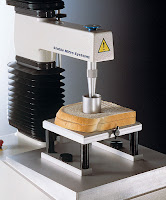The following are recent publications highlighting the use of a texture analyser to measure the effects of such formulation change.
Scientists from Nanjing University of Finance and Economics have been researching the effects of whey and soy protein addition on the rheological properties of wheat dough.
Since it is known that the gluten network is responsible for viscoelastic properties in wheat dough and for dough structure strength and gas retention, most studies reported that enrichment of
foreign proteins interfered with gluten development and so had negative effects on bread quality. This study compared the effects of whey and soy proteins on the thermomechanical, dynamic rheological and microstructural properties of wheat dough and bread-making quality in a relatively wide range of protein addition (0–30%).
They used their TA.XT2i Texture Analyser to perform texture profile analysis on breadcrumbs. The results suggested that selection of the protein source and amount with appropriate functionalities significantly affected the structure of the dough and quality of the bread.
This study is essential for product development and process control when considering the popularity of protein fortified bakery products.
Read more >
Researchers from Monterrey Institute of Technology have been investigating rheology, acceptability and texture of wheat flour tortillas supplemented with soybean residue.
Dry soybean residue is a by-product rich in dietary fibre and protein with high levels of essential amino acids. This study investigated the effects of the substitution of refined wheat flour with dry soybean residue in dough rheology and hot-press tortilla texture, dimensions, colour, protein and dietary fibre contents.
They used their TA.XT2i Texture Analyser to perform texture profile analysis on optimally developed doughs. Results indicated that wheat flour tortillas with 10% soybean residue were an excellent alternative to regular counterparts owing to their higher dietary fibre and protein quantity and quality.
Read more >
Scientists from the University of Bologna have been researching the influence of the addition of soy product and wheat fibre on rheological, textural, and other quality characteristics of pizza.
In this work, the effects of using new ingredients (e.g., soy paste, wheat fibre) on the rheological, textural, physicochemical, nutritional, and organoleptic characteristics of an enriched pizza type were investigated both at laboratory and industrial levels using their TA.HDi Texture Analyser to perform physical testing on dough samples. The new pizza provides a product that combines solid technological performances, in terms of rheological properties and dough elasticity, with improved and balanced nutritional quality, thanks also to the ingredients used in the topping.
Results demonstrate the possibility of obtaining new pizza products characterised by nutritional and sensorial properties tailored for different groups of consumers.
Read more >
A patent has also recently been released by Campbell Soup Company, entitled ‘Gluten Free Compositions and Methods for Producing Shelf-Stable Breads and Other Bakery Products’.
New bread flour substitute compositions were outlined including starch and hydrocolloid blends. The freshness (staling) of bread is generally monitored by measuring the changes in firmness of loaf over its shelf life, and their TA.XTplus Texture Analyser was used to perform these measurements according to the AACC method. Amylose reduced gluten free breads were found to have consistently lower firmness values than the control gluten free bread.
Read more >
For more information on how to measure texture, please visit the Texture Analysis Properties section on our website.
 The TA.XTplus texture analyser is part of a family of texture analysis instruments and equipment from Stable Micro Systems. An extensive portfolio of specialist attachments is available to measure and analyse the textural properties of a huge range of food products. Our technical experts can also custom design instrument fixtures according to individual specifications.
The TA.XTplus texture analyser is part of a family of texture analysis instruments and equipment from Stable Micro Systems. An extensive portfolio of specialist attachments is available to measure and analyse the textural properties of a huge range of food products. Our technical experts can also custom design instrument fixtures according to individual specifications.No-one understands texture analysis like we do!
To discuss your specific test requirements, click here...
 |  |  |



No comments:
Post a Comment